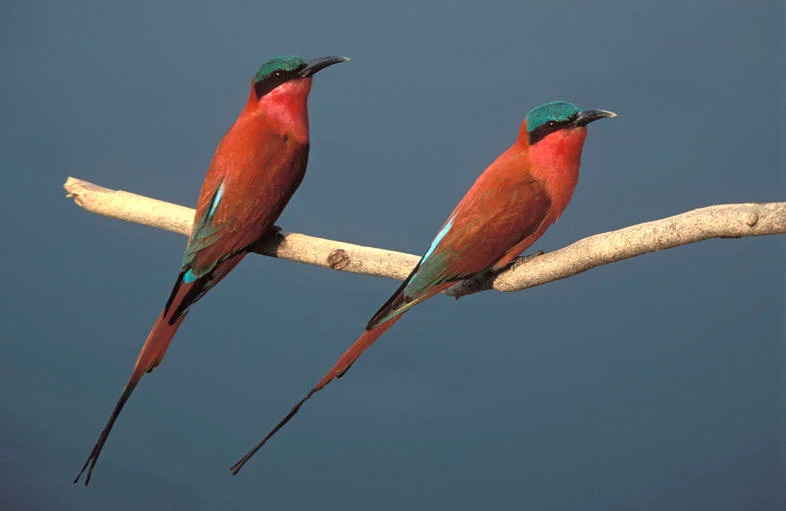With summer around the corner, we look at our flying summer visitor, the Southern Carmine Bee-eater. One of the more colourful bird species in Southern Africa and a must have on any bird lovers list.

Common Names
Carmine Bee-eater (English), rooiborsbyvreter (Afrikaans); iNkotha-enkulu (isiZulu) and Nkhonyana (Xitsonga).
The Mandinka people of West Africa (southern Mali, eastern Guinea and northern Ivory Coast) have coined the name ‘Cousin to the fire’. The birds are referred to as such because they attend fires in pursued of insects fleeing the flames.
Colourful Appearance
This species, like other bee-eaters, is richly coloured and is predominantly carmine in colouration, but the crown and undertail are blue. They’re the largest of the southern African bee-eaters, with a length of approximately 25 cm excluding the 12 cm tail streamers.
Migration
The bee-eater is a migratory species, spending the breeding season, between August and November, in Zimbabwe and Zambia, before moving as south as South Africa for the summer months, and then migrating to Equatorial Africa from March to August.
Diet and Nutrition
The adult bee-eaters are mostly aerial foragers, their diet consists of various invertebrates (dragonflies, termites and locusts), small fish and their chicks are exclusively insectivorous. One of the behavioural traits the species has acquired, is the ability to form social relationships with other animal species.
Both the Southern Carmine Bee-eater and the Northern Carmine Bee-eater sister species have been recorded hitch-hiking on large mammals (buffalo) and large birds (Kori Bustard) when foraging. They often carry prey back to a perch, where they rub the prey against the perch to kill it. This method is effective in de-stinging bees and wasps. They frequently regurgitate pellets consisting of insect exoskeleton.
Bee-eaters are often spotted pursuing grass fires. This opportunistic strategy allows them to feast on insects fleeing the fire. Their migration route may trail that of locusts, which gain them access to a steady food source to maintain their energy needs for the path ahead.

Habitat
Within South Africa the species is adapted to open savanna habitats. The characteristic sparse savanna terrain offers an advantage to the birds when it comes to hunting insects. Due to their high affinity to water bodies, bird colonies are usually located on flood plains associated with the rivers where they breed. They form nesting burrows on dry sandbanks. They are often spotted perching on plants suspended above aquatic systems.
Breeding
Southern Carmine Bee-eaters form monogamous breeding relationships, thus committing to a single partner. The courtship behaviour involves males offering females gifts in the form of insects, and coitus follows as the female accepts the male’s advances. Normally the female reproduces about 2–3 eggs, however, the chicks’ survival rate is low due to food scarcity.
Both adult and immature bee-eaters have different sounds of vocalisation. Adults produce distinct calls for threats and courtship. Visual displays of fending off other birds involves the fluffing of upper body feathers, and females usually mimic juvenile posture to receive a gift from males during courtship.
Social life
As highly sociable birds, they breed in sizable colonies of around 1000 nests on sandbanks. Southern Carmine bee-eaters perch alongside each other on flora overhanging water bodies, aerial pursuits and clashes have been observed.
Threats
Due to its extravagant plumage, some cultural groups kill the birds for their colourful feathers, and at times for food. Some beekeepers are convinced the species pose a threat to their honey-bee farms.
Dingos (Canis familiaris dingo), monitor lizards (Varanus varius), yellow-footed antechinus (Antechinus fiavipes), and cane toads (Rhinella marina) are the most significant predators for rainbow bee-eaters. These predators mainly prey on their eggs and chicks.
Conservation
On the IUCN Red List, it is classified as Least Concern as, due to its wide distribution, it does not meet the criteria to be classified as Vulnerable. The exact number of the population has not been quantified and Southern Carmine Bee-eaters’ population is believed to be decreasing. Although the populations number is declining, the decline is not rapid enough for the species to be of conservation concern. For a species to be considered of concern, its range should not exceed 20 000 km2.
Various anthropogenic activities pose a threat to the species. The alarming use of insecticides for insect control, the disruption of rivers due to dam construction, and their over-exploitation for food consumption leads to the declining of the population.

Animal Family
Merops Nubicus (Northern Carmine Bee-eater) is a sister species of the Southern Carmine Bee-eater. The species has not been documented in South Africa; it is nomadic to Zambia. Interestingly, although spatially separated, these two sister species have evolved the similar behaviour of hitch-hiking on large birds, specifically the Kori and Arabian bustards. Bee-eaters are from the order Coraciiformes. They are related to rollers, kingfishers, hornbills, among an array of diverse other bird species.
Fun Facts
They are masters of ‘hawking’, a hunting technique where birds launch from a perch, catch an insect from mid-air and return to the same or a different perch.
During the breeding season, the females will eat snail shells, sand and other calcium-rich items to help produce stronger eggs.
Most of the species in the family are monogamous, and both parents care for the young, sometimes with the assistance of other birds in the colony, a behaviour rather unusual for birds.
These birds of the world have an average lifespan of seven years while living in the wild. At times, their lifespan might extend to 10-12 years.
During the breeding period to lay eggs, female birds remove the eggs of the original inhabitant of the nest that they inhabit as their own.
The species plays a significant ecological role in the ecosystem, its biological pest control role ensures that insects are kept in check, also ensuring a balance in the ecosystem and elimination of weak members in insect populations. They are amazing creatures to observe in the wild and they make breath-taking pictures, especially when they’re perched on a Buffalo.
